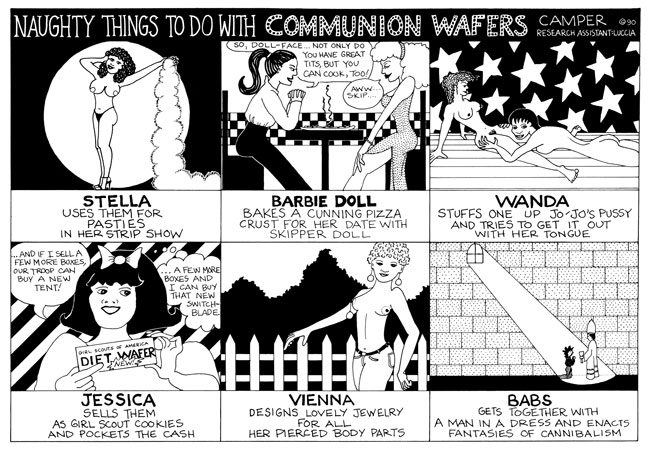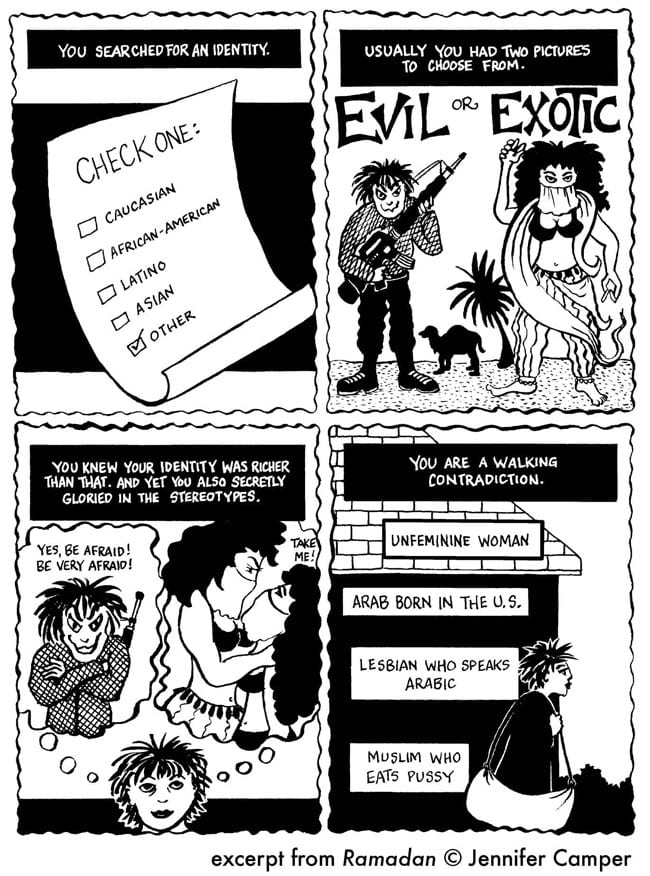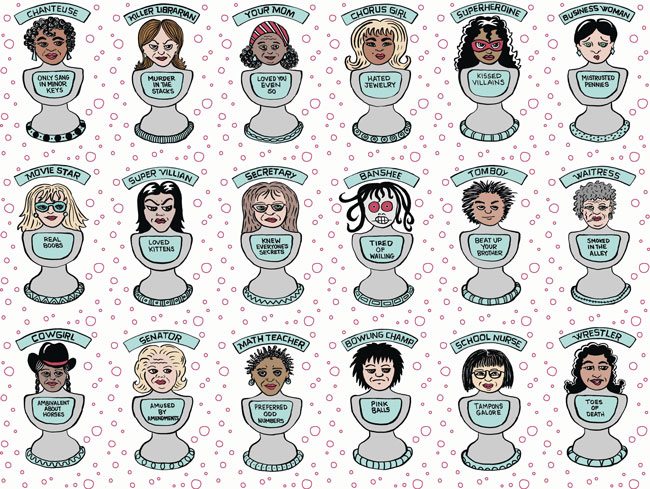
Jennifer Camper is one of the true stalwarts of both queer and feminist comics. In the early '80s she began producing work for North American LGBTQ newspapers and periodicals, as well as several classic underground comix titles. She’s been going strong ever since. Although her comics and stories regularly exhibit a fierce, often rude comic sensibility (Robert Triptow once referred to her work as "thumb to nose"), scores of her fellow cartoonists know her as a warm, friendly, down-to-earth colleague and collaborator—and one of our most dedicated rainmakers. Over the last thirty-plus years she has curated or co-curated at least two queer comics gallery shows, put together and moderated cartoonist panels at various writers and comics conferences, instigated a number of multi-creator comics jams, and created Juicy Mother, a two-book queer/alt comix anthology. She's also been the Comics Editor for The Women’s Review of Books since 2006. In May 2015 her most ambitious effort came to glorious fruition: the two-day Queers & Comics conference at the Center for Lesbian and Gay Studies (CLAGS) in New York City (the sequel of which will be happening next year). I've known Jen since I was just starting out as a cartoonist in the early '90s, and can attest to the fact that she always has irons in the fire. I emailed with her in mid-April to get some of her history down for the record and to catch up with what’s brewing in Camperland.
Rob Kirby: Jen, as long as we’ve been friends and as long as I’ve followed your work prior to that, I still don’t really know your cartoonist origin story. That seems as good a place to start as any, so how about it?
Jennifer Camper: I never decided to become a cartoonist. I sort of fell into it and just continued. From early childhood I played with all kinds of art forms, including comics and illustrated stories. In school, I made comics and illustrated stories as class assignments, or for the school paper, and sometimes just to entertain my friends and myself. My family encouraged this. I was reading underground comics in my teens, and discovered Mary Wings and Roberta Gregory’s dyke comics. After that, I found Wimmen’s Comix, Tits & Clits, Lee Marrs’ Pudge, Girl Blimp, and Gay Comix. I never doubted that there was room for my own voice in comics.
Next, I drew comics and illustrations for Gay Community News in Boston. Following that, I submitted comics to Gay Comix, and met Howard Cruse, who generously tutored so many of us in the craft and business of comics. I also published comics and illustrations in Wimmen’s Comix, Young Lust, Real Girl, Sojourner (Boston feminist paper), and On Our Backs (lesbian erotica magazine).
After a while, I created a self-syndicated, bi-weekly comic, Camper, that ran in a number of queer and feminist newspapers and magazines in the US and Canada. Those comics were eventually collected in my first book, Rude Girls and Dangerous Women (Laugh Lines Press, 1994).
Having these outlets gave me deadlines and assignments, and an audience. Of course, there was little money paid for these comics, but the queer press and alternative comics had a vocal readership. I was thrilled to get feedback for my work – both pro and con. Most of these publications were printed on cheap paper, so I developed my high-contrast, black and white drawing style, which reproduces well, even with low-quality printing production.
Those were heady days, to be sure. I think of your work from that era as quite groundbreaking: no one else was offering up images of women like you were. Can you tell me a bit about what inspired some of those strips and what kind of reactions you got? I’m thinking of comics like “Nature’s Call” (from Gay Comix #7) where you show what really happens when women all go to a public restroom at the same time (they basically have an orgy), or the superheroine parody “Ironwoman”, which depicts the titular character slicing off a rapist’s dick with her “handy switchblade.” It’s comics like those that made you one of my favorite cartoonists from the 1980’s issues of Gay Comix.
Aww... thanks! Just doing my job! I wasn’t seeing my own life and opinions portrayed in the arts and media, so I had to do it myself. I was tired of seeing dykes shown as sad, downtrodden victims, who only have ever-so-gentle, white bread "lesbian tickle sex." I wanted to celebrate queer women having adventures, being sexy, dangerous, and victorious. My characters are mostly smart-assed, multi-racial, street smart, wild women. They ridicule their oppressors. They are proud and fearless. In my comics, dykes always get the last laugh.
I once heard you say on a panel at Outwrite that you'd been censored by just about every publication you'd ever run in. What was that like for you as a creator, is that a badge of honor in a way?
I'm happy when my comics create strong feelings, either pro or con. Many publications either refused to run specific comics of mine, or asked for changes, usually regarding sex, violence, or politics. Some queer and feminist publications were trying to portray their causes as "non-threatening" and "mainstream", and many of my characters were a little threatening and proudly non-mainstream. I understand that dilemma. I was making comics for my own community who understood my perspective, but a hostile, anti-queer audience could be put off by some of my work.
The concerns of representation are always changing. As the arts and media offer more representations of non-mainstream groups, we gain the luxury of variety. When there's only one dyke on TV, she has to be an impossibly perfect representation of all queer women. But when there are many dykes on TV, we can have more well-rounded characters – even some flawed characters.
Were there any comics in particular that caused a stir?
"Ironwoman" showed castration. I was asked to make the man more threatening to justify her actions. I had originally drawn the man as non-threatening because I thought it was funnier that way, and, besides, Ironwoman is never a victim. But when asked, I did make the change, although the man is still not really very threatening.

"Answers" was printed on a post card and mailed from Texas. It was seized by the post office for being "lewd and lascivious." Color me proud!

When AIDS activists protested at St. Patrick's Cathedral in NYC and a communion wafer fell to the floor, it caused much controversy. I drew "Naughty Things to Do with Communion Wafers" for Outweek Magazine, but it wasn't printed. However, later they did print it in an article about my work and censorship.

Yeah, that was a bit ironic. In general you got away with a lot, though. Did you ever have any run-ins with more orthodox or mainstream-type feminists?
Yeah, some folks complained about the sex in my comics. As I understand feminism, it's wrong when women are sexually degraded, or are reduced to nothing but sexual beings, but it's right to celebrate women's sexual enjoyment. If I show women lusting after other women, does that "objectify" women, or glorify their sexual adventures? Women's sexuality is powerful stuff – what is acceptable? What is destructive? The debate still goes on.
What I loved about your comics is what I loved about other comics like Howard Cruse’s Wendel and novels like Rubyfruit Jungle: they posited, with humor rather than sanctimony, that it was the world that was fucked up around queers, women, and sexuality–and that those things are actually awesome and should be celebrated. That insistence–that defiance–was enormously important for me to encounter as a young person trying to navigate the adult world.
Exactly — we are all searching for verification. In my comics I want to tell compelling stories from new perspectives. Sly, irreverent humor is a useful weapon. When an audience is smiling, comics can sneak in some powerful ideas. Also, laughing at yourself keeps you honest.
Let’s move ahead to some of your more recent comics. Your graphic novel SubGirlz (1999, Cleis Press) and stories like “Carbon City” (2013), delve into the science fiction and crime/noir genres, respectively, while “Ramadan” and “Night Shift", your contributions to the two issues of your mid-'00s anthology Juicy Mother, offer up first an exploration of Arab American identity, and then a slice of life tale of a blue collar dyke. These comics seem to me to be (in part) about you exploring all sorts of different tonal qualities than your earlier work, yet still with that unmistakable Camper “edge.” Do you have any comment on that?
I like to explore different formats. The single-page comics can be done quickly, and they distill an idea into a very concise essence. It's a lot like poetry. With longer stories, I can create complex characters, explore more nuances, and develop plots. Sometimes I use familiar genres like fantasy or noir, but revisited with my own dyke-centric flavor.
In all my comics, I'm exploring things like gender, race, class, and sexuality, and how they influence character and behavior. It's what those academic-types call "intersectionality.” Stories about Arab American dykes, women factory workers, or older lesbian assassins are rare, so it gives me fresh territory. Most importantly, I'm trying to captivate both my readers and myself with juicy and compelling tales.

What drives you to create things like cartoon art shows, comics jams, anthologies, and last year's big-ass Queers & Comics conference in NYC?
It's tough being an extroverted cartoonist. So I wrangle cartoonists together for jams, panels, readings, exhibits, and all kinds of crazy art projects. Editing and teaching comics is another way I get to work collaboratively.
I love how we all learn from each other. Most cartoonists are such introverts, so I enjoy introducing cartoonists to each other, like some demented matchmaker. Much of cartooning is self-taught – we just stumble into this business and figure it out as we go along. It's really helpful to have a cartoonist community that shares information.
I created The Queers & Comics Conference because I wanted to celebrate and document our history. I'm very grateful to CLAGS (Center for LGBTQ Studies) at CUNY Grad Center for hosting us. And I'm indebted to the brilliant André Carrington for all his help organizing the event.
I wanted to create an opportunity where over 100 LGBTQ cartoonists could just hang out together and talk about our craft. If we don't write our own history, it won't be preserved truthfully. I'm excited that there will be another Queers & Comics Conference in San Francisco in Spring 2017.
For the first Q&C, I edited "Queer Pin-Ups", a card deck with art donated by 54 cartoonists. We sold it as a limited-edition fundraiser. It's exciting to be able to create a comics artifact that's historic and sexy. And great for playing strip poker.



Yeah, I still have to get a good game going with my deck! Since you brought up the subject of community, I wanted to ask you about your local support system. Back in the late '90s when I lived in NYC, I remember attending several cartoonist gatherings at your place: Howard Cruse, Ivan Velez, and Joan Hilty would always be there, and sometimes out-of-towners like Alison Bechdel or Andrea Natalie managed to make it down. I remember Howard once even brought Paul Gravett along. Do you still manage to get together with the local folks nowadays?
I try to. There have been a lot of wild comics parties that are now just a blur in my memory. I know you were involved with some of those bashes, Rob!
Even though we can connect online, there’s something extra special when cartoonists get together. I love seeing other cartoonists’ original art – it’s like peeking inside their brains. I remember Howard painstakingly demonstrating his cross-hatching technique to Alison on my coffee table. And Ivan would draw tattoos on me with Sharpies. And how we’d form queer cartoonist gangs at conventions and terrorize the smelly het white boys.
Yeah, I do miss those parties (or whatever you’d want to call them)! Anyway, to wrap up, tell me what’s cooking on your drawing board at present?
I've been working on fictional stories, ranging in length from two to fifty pages. I'm exploring a range of topics and genres, but they're all darkly irreverent with sly humor and cocky female characters. It's comics as literary fiction.
I'm also doing projects that fuse comics with graphic design. I was commissioned to design wallpaper, entitled “Busts”, for a gallery exhibit. And I'm doing comics as greeting cards and illustrations.
Eventually, all this work will be complied into a book. I only wish I could figure out how to work faster.







